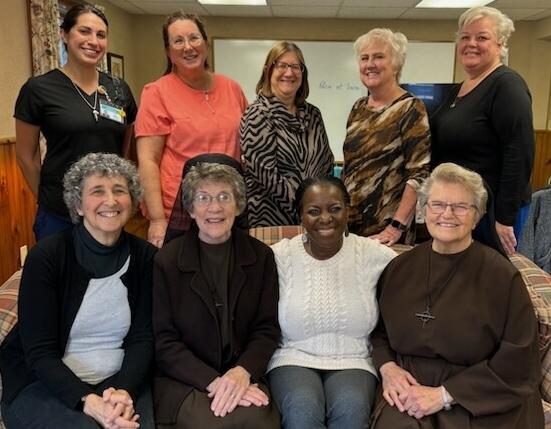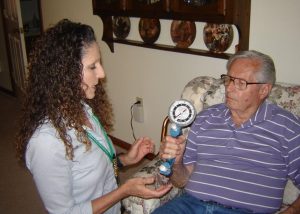
How may we serve you?
Hospice care is available to anyone who:
What is hospice care?
Hospice care is palliative care that focuses on serving and comforting patients and their families at the end of their lives or as the illness becomes terminal. Most hospice programs concentrate on comfort rather than cure. A medical specialty that provides for the whole individual through an interdisciplinary approach to the plan of care. It involves the person and their family at the center with the physician, nurse, social worker, pastoral care, home health aids and volunteers to create a team to meet the needs of the individual and the family. Physical, Occupational and Speech therapies might also be part of a hospice plan of care if the individual would benefit from these services. Most hospice patients can achieve a level of comfort that allows them and their families to concentrate on the emotional and practical issues of dying. Franciscan hospice care provides this type of care.
- Hospice care is covered by the Medicare Hospice Benefit available for patients whose life expectancy is six months or less, as determined by their physician
- Medicaid hospice coverage is the same as the Medicare benefit
- Some commercial insurance companies also offer hospice coverage. If you are unsure of coverage, contact your insurance company
- In most cases, hospice is provided in the patient’s home
- Hospice care is also provided in freestanding hospice facilities, hospitals, or nursing homes
- Now is the best time to learn more about hospice and ask questions about what to expect from hospice services
What levels of Hospice Care are available?
There are four levels of hospice care available from Medicare Hospice Benefit because patients require different intensities of care during the course of their disease.
1
Routine Hospice Care
Routine Hospice Care is the most common level of hospice care. With this type of care, an individual has elected to receive hospice care at their residence/home, which can include a private residence/home, assisted living facility or nursing facility.
2
Continuous Home Care
Continuous Home Care is care provided in the home between 8 and 24 hours a day to manage uncontrolled pain and other acute medical symptoms. Continuous Home Care services must be predominately nursing care, supplemented with caregiver and hospice aide services and are intended to maintain the terminally ill patient at home during a pain or symptom crisis.
3
General Inpatient Care
General Inpatient Care is provided for pain control or other acute symptom management that cannot feasibly be provided in any other setting. General Inpatient Care begins when other efforts to manage symptoms have been ineffective. General Inpatient Care can be provided in a Medicare certified hospital, hospice inpatient facility, or nursing facility that has registered nursing available 24 hours a day to provide direct patient care. It is the individual needs of the patient (not the location of care or caregiver breakdown) that determines if patient qualifies for General Inpatient Care level of care. A patient who is actively dying is not, in and of itself, a reason for General Inpatient Care.
4
Inpatient Respite Care
Inpatient Respite Care is available to provide temporary relief to the patient’s primary caregiver. Respite care can be provided in a hospital, hospice facility, or a long-term care facility that has sufficient 24-hour nursing personnel present on all shifts to guarantee that patient’s needs are met. Respite care is provided for a maximum of 5 consecutive days.
Hospice Care Services
FAQ
Individuals and their families benefit most when they have more time with a hospice than just a few days or weeks. This supportive service, during a most challenging time, is based on trust and relationship building that can best occur over months of care, rather than just the last few days.
As a hospice patient you get to choose who you want to be your attending physician as part of your hospice team. That doctor will consult with the Hospice Medical Director to provide you the best care.
Some hospices have inpatient units where care may be provided, but in most cases care is offered in the patient’s own home, the home of a family caregiver, an assisted living or skilled nursing facility. Hospice care comes to wherever the patient resides.
Hospice care is for patients with any health condition that, as determined by 2 doctors, is likely to have a prognosis of six-months or less. Some of the health conditions include heart disease, lung disease, liver disease, Alzheimer’s disease and many others.
Recent studies have shown that patients who choose hospice care actually live longer than those who pursued curative, intensive medical interventions. This may be due to the additional support and allowing for the natural dying process that hospice can provide.
Hospice is covered by the Medicare Hospice Benefit, Medicaid and many private insurance companies. Contact your insurance provider to obtain specific information about your coverage.
Pain control is only one important part of effective symptom management that is provided by hospice. Hospice care is a multi-disciplined approach that includes the social, emotional and spiritual aspects of the whole person. Bereavement support for over a year following the loss is also a crucial, supportive component of hospice care for the family.
There is no 6 month limit to hospice services. Patients must be re-assessed for eligibility at regular intervals in order to meet ongoing coverage criteria, but there is no limit on the amount of time a patient can be on the hospice benefit.
Hospice care is a type of Palliative care that is focused on comfort and no longer seeks curative measures. No one is giving up! In fact some patients improve and no longer require hospice services. They may choose hospice again if the need arises.
You are free to discontinue hospice at any time. Most patients and their families are relieved to know that they are in control of their own care and can get the support of hospice when they need it.









